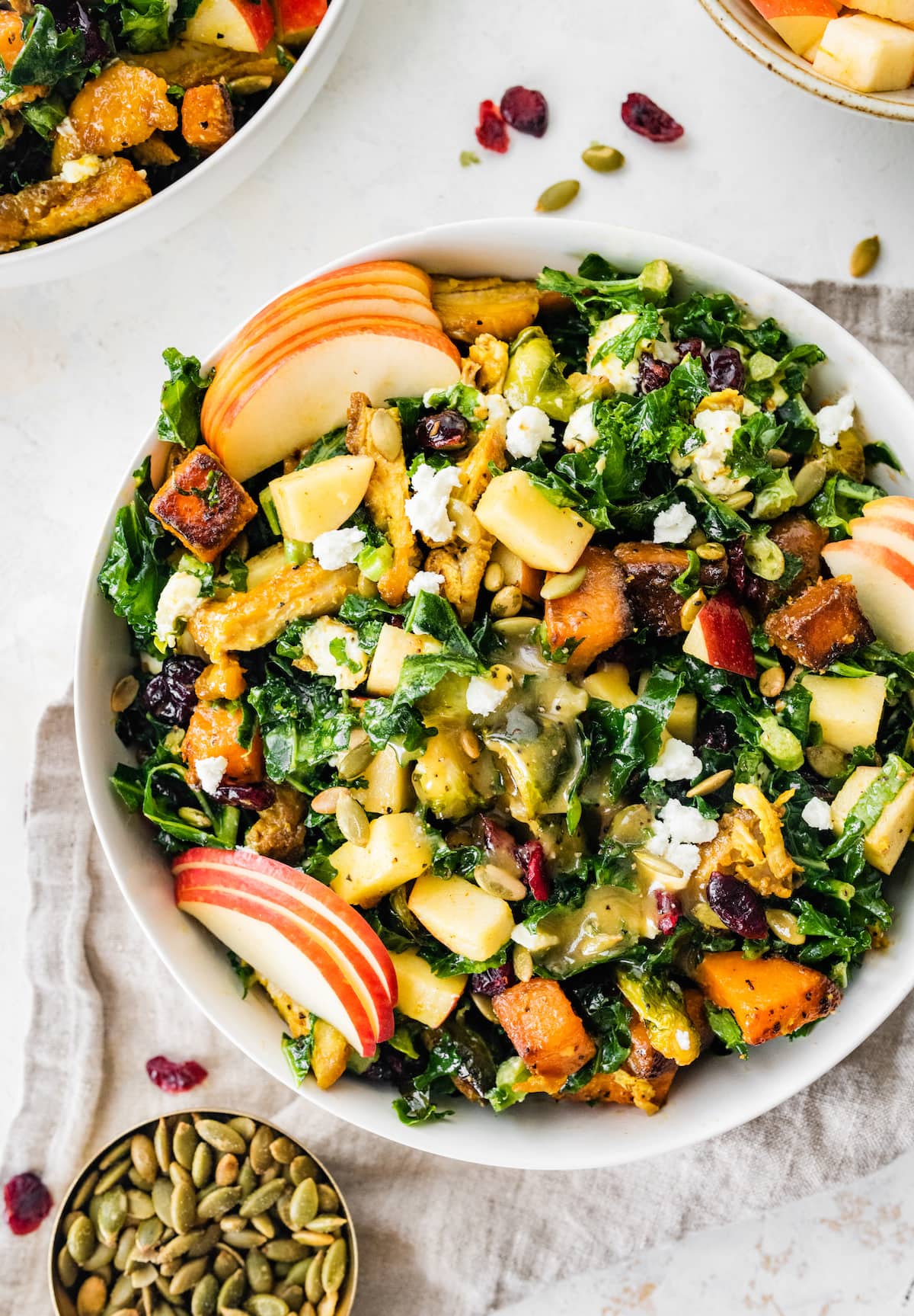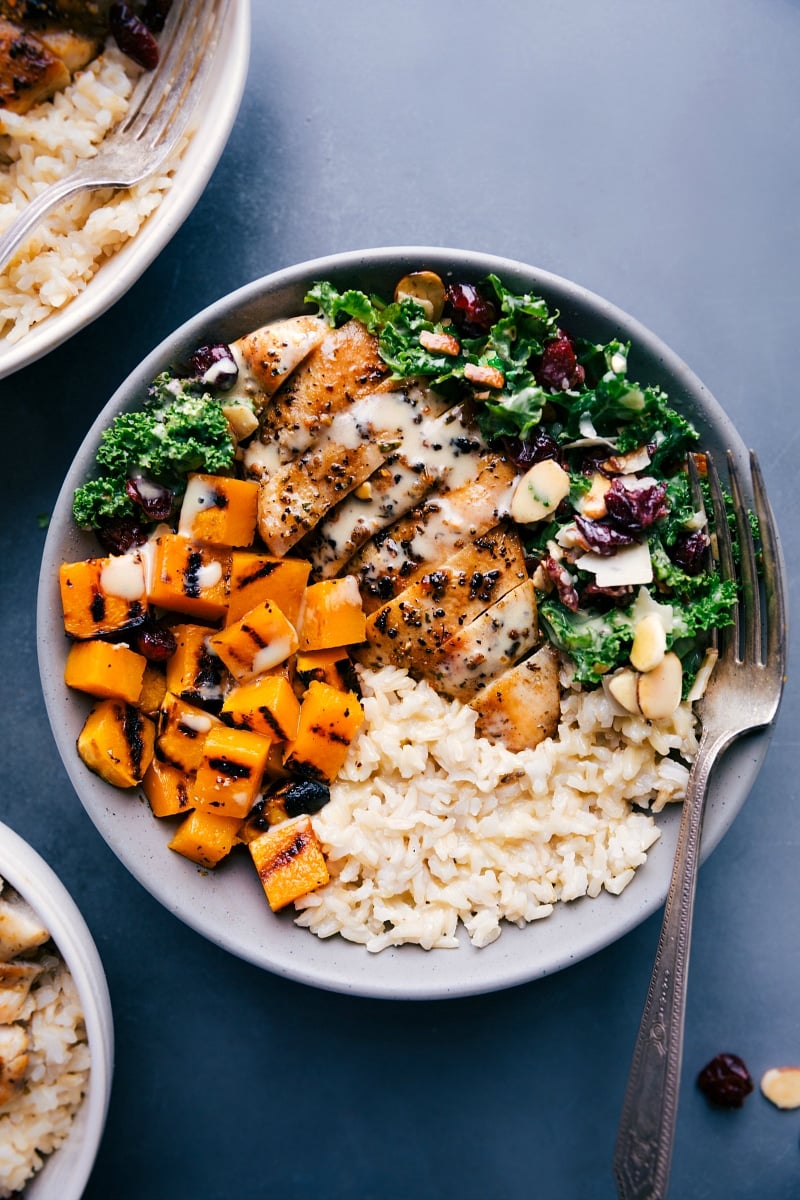Harvest Bowl

A Harvest Bowl is a nutritious meal featuring seasonal vegetables, grains, and proteins. It offers a balanced and flavorful dining option.
Harvest Bowls have gained popularity for their health benefits and delicious taste. They typically include a variety of fresh, seasonal vegetables, a base of whole grains like quinoa or brown rice, and a source of protein such as chicken, tofu, or beans.
These bowls are not only visually appealing but also rich in vitamins, minerals, and fiber. They cater to various dietary preferences, making them a versatile option for any meal. Whether you are looking for a quick lunch or a hearty dinner, a Harvest Bowl provides a satisfying and nutritious choice that supports a healthy lifestyle.

Credit: www.eatingbirdfood.com
Introduction To Harvest Bowls
Harvest Bowls offer a nutritious blend of grains, proteins, and vegetables, perfect for a balanced meal. Enjoy a burst of flavors with every bite, ideal for health-conscious individuals.
Origins And Evolution
Harvest bowls have ancient roots. They come from farming communities. People used what they grew. They mixed grains, vegetables, and proteins. This made a full meal in one bowl. Over time, the idea spread. Today, harvest bowls are trendy. They are a symbol of healthy eating. Many cultures have their versions. Each one tells a story of the land and people.
Why They’re Popular
Harvest bowls are easy to make. They are also very healthy. You can use fresh ingredients. These bowls are also versatile. You can mix and match items. Every bowl can be different. They are also visually appealing. Many people share photos of them online. This has increased their popularity. Restaurants also offer them. They cater to health-conscious diners.

Credit: www.chelseasmessyapron.com
Essential Ingredients
Discover the magic of a Harvest Bowl with nutrient-packed quinoa, roasted veggies, and tangy dressings. Savor the wholesome goodness in every bite.
Grains And Bases
Start with a sturdy base. Brown rice, quinoa, and farro are great choices. These grains provide fiber and protein. They are also rich in vitamins and minerals. For a lighter option, use mixed greens. Spinach and kale work well. Cauliflower rice is another low-carb option.
Proteins And Add-ins
Chicken, tofu, and beans are popular protein choices. These add flavor and nutrition. Eggs can also be a good addition. For added texture, use nuts and seeds. Pumpkin seeds and almonds are crunchy and delicious. Avocado provides healthy fats and creaminess. Don’t forget to add some cheese like feta or goat cheese.
Nutritional Benefits
The Harvest Bowl offers a mix of vegetables, proteins, and grains. Each bowl has fiber, vitamins, and minerals. It helps you stay full and energized. The bowl provides a good balance of carbs, proteins, and fats. This balance supports your body’s needs.
Eating a Harvest Bowl can improve your health. It can help you maintain a healthy weight. This meal can also boost your immune system. The bowl’s nutrients can promote better digestion. It can also help your heart stay healthy. The Harvest Bowl is a great option for a nutritious meal.
Building A Harvest Bowl
Start by picking a base. Use rice, quinoa, or greens. Next, add some proteins. Try grilled chicken, tofu, or beans. Remember to add colorful veggies. Carrots, bell peppers, and broccoli work well. Top with a delicious dressing. Use vinaigrette, tahini, or a simple olive oil and lemon mix.
Mix and match ingredients. Change the protein each time. Experiment with different veggies. Use seasonal produce for freshness. Don’t forget the toppings. Nuts, seeds, and dried fruits add a nice crunch. Try different dressings. A new dressing can change the whole flavor.
Popular Harvest Bowl Recipes
A classic harvest bowl is a tasty mix of grains and veggies. It often includes quinoa, roasted sweet potatoes, and kale. Adding some protein like chicken or tofu makes it even better. Top it off with a simple dressing of olive oil and lemon juice. This bowl is perfect for a healthy lunch or dinner.
Seasonal variations keep your harvest bowl exciting all year. In summer, use fresh tomatoes and corn. For fall, try roasted squash and Brussels sprouts. Winter bowls can feature root vegetables like carrots and parsnips. Spring is great for using fresh peas and asparagus. Mix and match to find your favorite combinations.
Serving And Presentation
Use a deep bowl for the Harvest Bowl. Place the grains or greens at the bottom. Add colorful vegetables and proteins on top. Arrange them in small, neat piles. Make sure each component is visible. This creates a beautiful, layered look. Keep the colors balanced and appealing. Avoid overcrowding the bowl. This makes it easier to eat and enjoy.
Top the Harvest Bowl with fresh herbs like parsley or cilantro. Sprinkle seeds such as sesame or sunflower for crunch. Add a drizzle of dressing or sauce. Use edible flowers for a pop of color. Thinly sliced avocado or radish adds elegance. Lemon or lime wedges on the side give a citrus twist. A dusting of spices can enhance the flavor. Garnishing makes the bowl look and taste amazing.
Harvest Bowls For Special Diets
Harvest bowls can be made vegan or vegetarian. Use fresh vegetables and plant-based proteins. Quinoa, lentils, and tofu are great choices. Add nuts and seeds for crunch. Avocado and hummus add creaminess. Pick a tangy dressing like lemon-tahini.
Harvest bowls can be gluten-free too. Choose quinoa or rice instead of wheat-based grains. Use gluten-free soy sauce for flavor. Roasted vegetables, lean proteins, and fresh greens make a tasty bowl. Top with gluten-free dressings. Yogurt-based dressings work well.
Sourcing Fresh Ingredients
Local markets offer the freshest produce. These markets support local farmers. Fresh ingredients taste better. They also have more nutrients. Local markets reduce the carbon footprint. This is because the food travels less distance. You can meet the farmers directly. This builds a sense of community. You know where your food comes from. You can ask questions about the produce. This ensures you get the best quality.
Making sustainable choices is important. Choose organic produce whenever possible. Organic farming uses fewer chemicals. This is better for the environment. Look for seasonal fruits and vegetables. They are fresher and more nutritious. Eating in season also supports local farms. Avoid produce that travels long distances. This reduces carbon emissions. Sustainable choices help protect the planet. They also ensure future generations have fresh food.
Tips From Chefs
Chefs say to always use fresh vegetables. Fresh vegetables taste better. They have more nutrients. Clean your vegetables well. Use a variety of colors. This makes your bowl look nice. It also gives you different nutrients.
Roast or grill your vegetables. This adds a smoky flavor. Don’t overcook your vegetables. They should still be a bit crunchy. Chefs also suggest using whole grains. Whole grains are healthier. They give you more energy.
Many people use too much dressing. This can make your bowl soggy. Use just a little dressing. Taste it first. Add more if you need it.
Another mistake is not seasoning your food. Salt and pepper are important. They make your food taste better. Don’t forget to season.
Some people forget about protein. Add beans, tofu, or chicken. Protein helps you feel full. It keeps you strong.

Credit: therecipecritic.com
Frequently Asked Questions
What Is A Harvest Bowl?
A Harvest Bowl is a nutritious, hearty meal featuring seasonal vegetables, grains, and proteins, all in one bowl.
How To Make A Harvest Bowl?
Combine roasted vegetables, grains, proteins, and a flavorful dressing. Customize ingredients based on personal preferences and seasonal availability.
What Ingredients Are In Harvest Bowls?
Common ingredients include sweet potatoes, quinoa, kale, chickpeas, and avocados. Feel free to add your favorite seasonal produce.
Are Harvest Bowls Healthy?
Yes, Harvest Bowls are nutritious. They are packed with vitamins, minerals, fiber, and protein, promoting balanced meals.
Can Harvest Bowls Be Vegan?
Absolutely, Harvest Bowls can be easily made vegan by using plant-based proteins like tofu, tempeh, or legumes.
Conclusion
Creating a Harvest Bowl is simple, nutritious, and delicious. This versatile meal suits any dietary preference. Enjoy the rich flavors and health benefits. Start experimenting with ingredients today. Your taste buds will thank you, and your body will reap the rewards.
Dive into the world of Harvest Bowls and elevate your meals.



